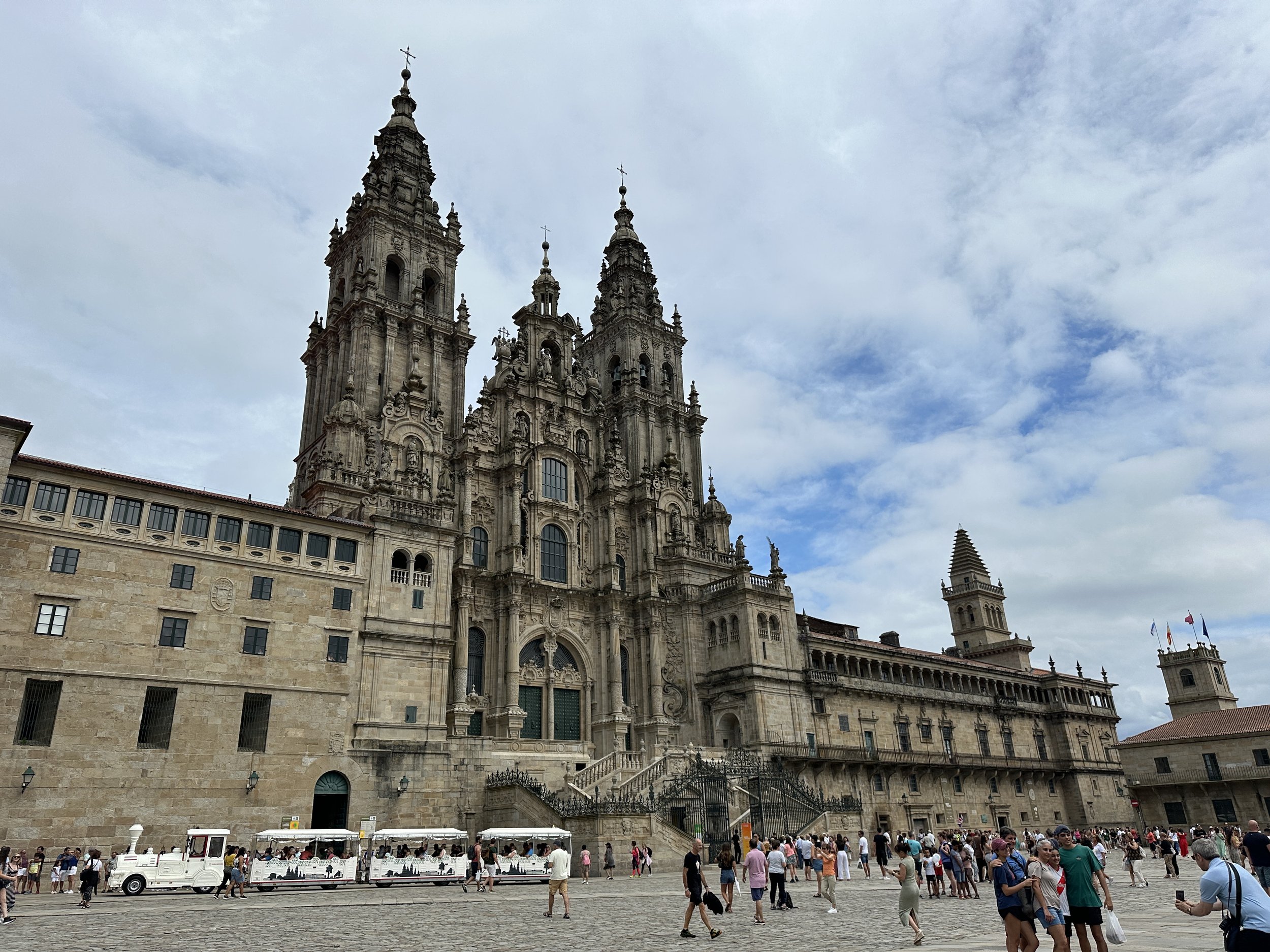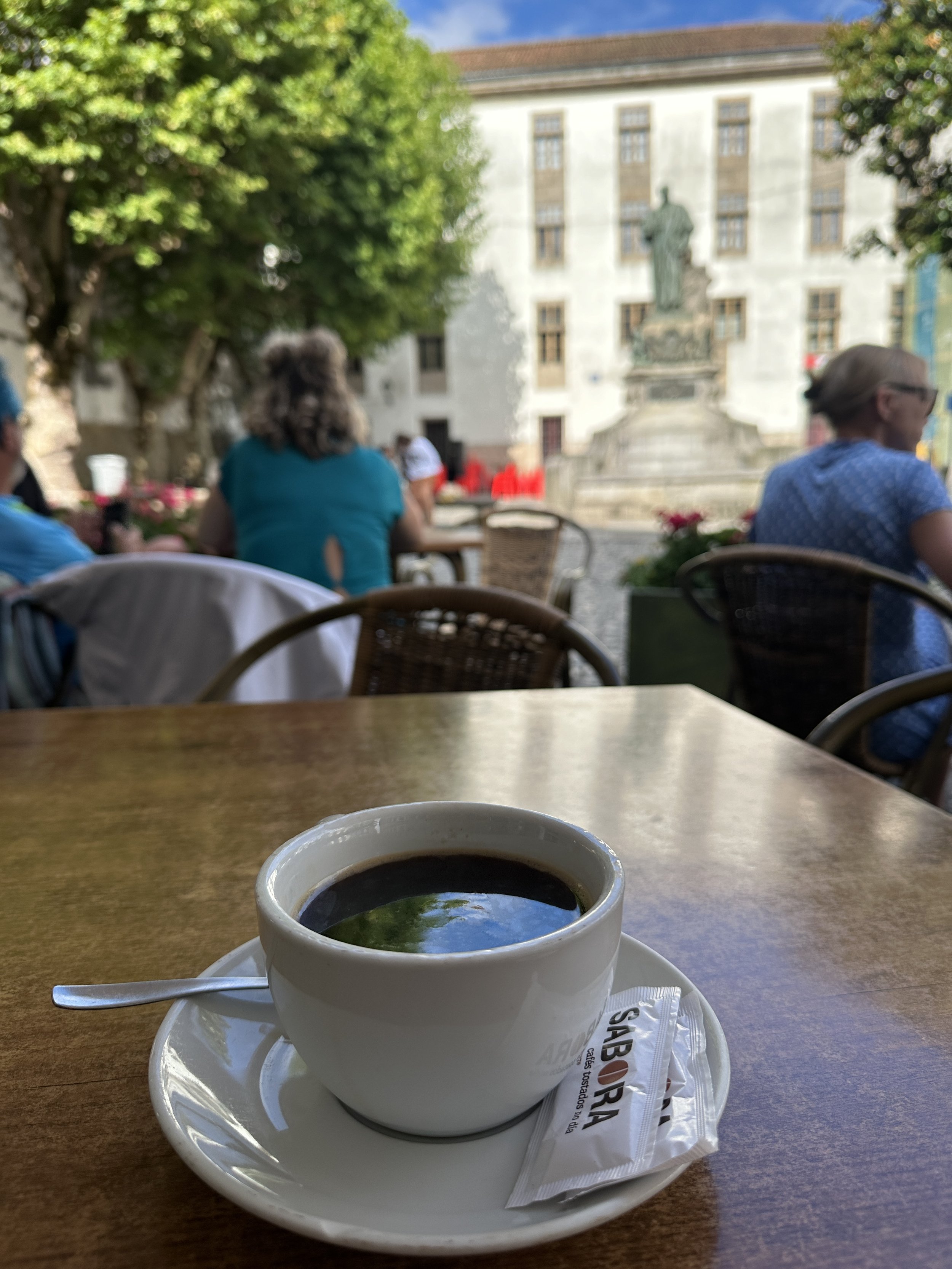Day 42 & 43 - RnR in Santiago de Compostela; Next Up: The End of the World
Date: Friday-Saturday July 26-27
Start: Santiago de Compostela, Galicia
End: Santiago de Compostela, Galicia
Daily Mileage: NA
Total Mileage: ~522mi (~840km)
After 522+ miles on the Camino del Norte, in addition to all of the unrecorded walking we did in towns to explore, get food, and run other errands, Shawn and I have taken a couple of days off to rest and see a bit of Santiago de Compostela.
It’s an absolutely beautiful city and we’ve enjoyed our time walking around, lingering over long lunches of delicious Galician fare, and just generally being around the festive atmosphere of the city. Beyond the celebration of Saint James Day, there is an infectious vibrant energy about the city as pilgrims from all over the world celebrate the finish of their journeys.
Rooftops of Santiago de Compostela
SOME INTERESTING STATS FROM THE CAMINO…
The day after finishing, Shawn and I took a look at the official Camino de Santiago statistics provided by the Pilgrim’s Reception Office, updated at the end of each day. It’s an interesting website, with various ways to filter and examine data pertaining to Camino finishes from each year, including filtering by route or looking at the full statistics for all routes combined.
JULY 25 FINISH (our finish date)
# of Finishers (all Camino routes) on July 25: 1,860
# of Finishers (Camino del Norte) on July 25: 113
*it’s worth noting that both the day before and after July 25, there were closer to 2,500 finishers each day, so maybe these people knew something we didn’t!
ALL FINISHERS YEAR TO DATE THROUGH JULY 25
# of Finishers (all Camino routes) through July 25: 260,879
# of Finishers (Camino del Norte) through July 25: 10,603
Most popular camino routes. Source: oficinadelperegrino.com
MOST POPULAR CAMINO ROUTES
Of the Camino de Santiago routes traveled to arrive in Santiago de Compostela, the Camino Francés is the most popular, by far. Thus far this year, the Camino del Norte is only the sixth most traveled route by number/percentage of finishers. We really liked this, as we felt like we had the opportunity to meet a good number of people, but the route was by no means overcrowded.
Breakdown of recorded finishers by trail so far this year (through July 26):
Camino Francés: 124,994 (47.5%)
Portugués Way: 50,948 (19.4%)
Portugués Coastal Way: 39,285 (14.9%)
Camino Inglés: 14,163 (5.4%)
Camino Primitivo: 12,397 (4.7%)
Camino del Norte: 10,705 (4.1%)
Percentage of pilgrims by start location, Camino del Norte. Source: oficinadelperegrino.com
CAMINO DEL NORTE START LOCATIONS
While the most popular start location for the Camino del Norte is along the Spain/France border in Irún, where we started, pilgrims can start their journeys wherever they want. We met pilgrims from both Belgium and the Netherlands that had started their journeys in their hometowns. Others walk the bare minimum distance to officially qualify to receive a Compostela, which is 100km. Of those that have finished the Camino del Norte this year (through July 25),
# of Finishers that started in Irún (522mi/840km to Santiago): 3,178 (~32% of finishers)
The next most popular cities to start the Camino del Norte were:
Ribadeo (~120mi/193km to Santiago): ~9.2%
Vilalba (74.2mi/119km to Santiago): ~8.7%
Bilbao (428.3mi/689km to Santiago): 6.3%
MODE OF JOURNEY
Of those traveling the Camino del Norte,
85% are arriving on foot (walking)
12% are arriving by bicycle
The remainder either left the field blank on their form or are arriving by horse, wheelchair, or some other form of assisted walking device
These stats vary a little when you filter for all Camino routes. The overall breakdown includes a higher percentage of walkers. For all Camino routes combined:
93% complete the journey on foot
4.8% complete the journey by bike
The remainder is all other modes of travel (noted above)
Percentage of pilgrims by country, Camino del Norte. The top five countries represented are Spain, Germany, United States, France, and Italy. Source: oficinadelperegrino.com
COUNTRIES REPRESENTED
Pilgrims who have recorded finishes this year (across all routes) have represented a total of 183 different countries – some of which are technically territories of other countries, but 183 distinct geographic regions is still quite high. Spain is, for obvious reasons, the most represented country across all routes, including the Camino del Norte.
Country of Origin - Camino del Norte Finishers
Spain: 39%
Germany: 9.4%
United States: 8.1%
France: 6.7%
Italy: 4.8%
All others countries were under 3%
We actually only met a couple of other Americans and a couple of Germans on the trail. After Spanish natives, we saw/heard/met pilgrims from France and Italy the most frequently. Granted, if we had stayed in albergues more often we may have had more interaction with pilgrims from a wider range of countries. This breakdown varies a bit from that of finishers for all routes combined.
Country of Origin – All Finishers (All Routes Combined)
Spain: 40.7%
United States: 8.5%
Germany: 5.7%
Italy: 5.3%
Portugal: 5.1%
All other countries were under 3%
This was only a small selection of the interesting statistics you can find on the Pilgrim’s Office Statistics page. If you want to dig a little deeper, you can filter by trail, year, etc. here. Also, it’s worth noting that the statistics above reflect only those who are registering their Camino with the Pilgrim’s Office. There are many who don’t register, for various reasons – particularly if they have done a Camino in the past and no longer care to receive a Compostela. Still others do the route in sections, sometimes over many years; their presence on a Camino would not be captured until their final leg, upon registration and the final visit to the Pilgrim’s Reception Office.
Alameda Park
While our hike to Santiago de Compostela was amazing, our journey isn’t quite over yet.
When meeting other pilgrims along the Camino del Norte, the most common questions, beyond the typical pleasantries of where you’re from, are, in order:
Where /when you started
Whether you plan to go all the way to Santiago de Compostela, and if so,
If you will continue to Finisterre/Muxia
Following the Camino de Santiago, some pilgrims choose to extend their journey by continuing to ‘the end of the world’ – the seaside town of Finisterre. Located along Spain’s westernmost coast, in old times Finisterre was known as ‘the end of the world’, as it was quite literally the edge of the known map at one time. The name Finisterre directly derives from Latin, meaning finis (end) terrae (earth).
The Camino Finisterre is the only route that starts, not ends, in Santiago de Compostela, beginning right from the Catedral plaza where the Camino de Santiago ends. Very convenient.
And where you end, you shall begin again…
Having started our walk along the Bay of Biscay at the Spain/France border, we find the idea walking all the way across Spain, finishing at the Atlantic Ocean, to be a far more satisfying end point to our journey than the Catedral in Santiago de Compostela. While this was certainly gratifying, there is just something special about finishing along the coast and staring out at the endless blue. Also, there is a certain finality to it – well, that’s as far west as I can go. I’ll need a boat now.
And so, yes – assuming that we made it to Santiago de Compostela (✅), we had always planned to continue to Finisterre. Like other routes, there are several different variations/options for the Camino Finisterre. Many people who walk this Camino also include the coastal town of Muxia in their itinerary, either as an alternative to Finisterre or as an add-on before or after Finisterre. Because we’ve read that both towns have very different vibes and are each worth visiting, we are including both in our four day journey.
And so, tomorrow our journey continues!
Just cheesin’ while Shawn is getting a massage.
In between a bit of exploring, we’ve spent the last two days in Santiago resting up for this last leg of the journey. (Really, I promise, this is the last stretch this time – no more add-ons).
With that, I’ll leave you with a bit of a photo summary of our last couple days in Santiago de Compostela, which – despite its touristy nature – we really loved. It has a beautiful historic quarter, really lovely parks, and a great selection of both Galician and international cuisine. It also helped that we had really great weather while we were here. What we were up to...
First, a quest:
I had a little mission to find the spot from this painting in our hotel room.
So, I pretty much found it. It wasn’t too hard to figure out that it was in Alameda Park, but I couldn’t find any bench locations where the rooflines lined up just as they were in the painting. Also, the trees need some serious trimming. Lol.
But, here’s a better picture of the skyline from a different vantage point in Alameda Park.
More strolling in Alameda Park.
A bit of marine art:
Monasteiro de San Martiño Pinario
Out front of the monastery, there was a giant ground mural created with crushed seashells and flowers which tied together global sites, the Olympics (five rings), the Camino, and Santiago de Compostela. Interesting theme, quite beautiful.
More art & architecture:
Belvis Convent, Belvis Park
There’s that cathedral again… Catedral de Santiago de Compostela, Praza do Obradoiro
Porto ou Arco de Mazarelos - all that remains of the medieval city wall.
Interior courtyard, Monasteiro de San Martiño Pinario
Depiction of the body of Saint James being returned to the Iberian Peninsula by stone boat. Cathedral Museum.
Cathedral Museum library. I just love a good library.
Cathedral balcony view over Praza do Obradoiro and the town hall.
Other fun finds:
In the Museum of Pilgrimage, among other interesting exhibits, was this backpack. To keep the spirit of the Camino alive during COVID, this backpack traveled the Camino Francés relay style, with over 100 locals carrying it across the various provinces and regions of Spain from Roncesvalles to Santiago de Compostela from June 19 to July 24, 2020. Along the way, pilgrims added patches, photos, and other Camino symbols and trinkets to the pack and filled a journal about the travels.
Mercado de Abastos
Gaita (bagpipe) player at an entrance to the cathedral plaza.
Strolling & yums:
Afternoon coffee breaks
And plaza strolling...
Narrow laneways...
And balanced breakfasts.
Pretty views,
Galician Ribeira Sacra wine,
And obviously, dessert.
All capped with fantastic sunsets.
The journey continues tomorrow!































